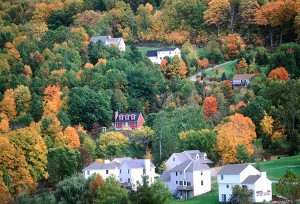The Autumnal Equinox: Fall Is Here!

A Connecticut village in autumn is ablaze with the brilliant colors of turning leaves. Every year, many vacationers visit the state to enjoy its scenic countryside and to explore its many picturesque villages and historic sites.
Credit: © Corbis Bridge/Alamy Images
Fall means pumpkins, colorful leaves, and crisper weather. It also means the end of summer. What causes the seasons to change? The four seasons result from the tilt of Earth’s axis of rotation and the planet’s motion around the sun. The axis slants at an angle of 23 degrees 27 minutes in relation to the plane of Earth’s orbit. As a result, Earth’s Northern and Southern hemispheres tilt toward or away from the sun during different times of the year. Some people mistakenly believe that seasons result from Earth moving closer to or farther from the sun at different times of the year. But Earth orbits at nearly the same distance from the sun throughout the year. The small changes in distance that do occur have little effect on Earth’s weather.
Tomorrow, September 23rd, at 2:50 a.m. Eastern Time, the autumnal equinox marks the beginning of autumn in the Northern Hemisphere. In the Southern Hemisphere, where the seasons are reversed, the event is called the vernal equinox and marks the start of spring. The word vernal means of spring. An equinox is either of the two moments each year (the other is in March, again changing the seasons) when the sun is directly above Earth’s equator. On the days of the equinoxes, all places on Earth receive approximately 12 hours of sunlight. Today, the sun rose at 6:43 a.m. Eastern Time and will set at 6:53 p.m.—a total of 12 hours and 10 minutes of daylight. The term equinox comes from a Latin word meaning equal night. The equinoxes occur at different times of day each year on March 19, 20, or 21 and on September 22 or 23.
The time interval from the March equinox to the September equinox is longer than that between the September equinox and the next March equinox. This time difference results from the Earth’s elliptical (oval-shaped) orbit around the sun. Our planet moves faster in its orbit when it is closer to the sun. The distance between the Earth and the sun is shortest in January. Therefore, the Earth completes the semicircle from the September equinox to the March equinox faster than it does the opposite semicircle.
Astronomers also use the term equinox for either of two imaginary points where the sun’s apparent path among the stars crosses the celestial equator. The celestial equator is an imaginary line through the sky directly over the equator.
After the autumnal equinox, the weather cools and nights become longer than days, and days continue to shorten until the winter solstice. The weather then warms and daylight begins its recovery toward the summer solstice in June. The winter solstice is technically the shortest day of the year, and the day of the summer solstice enjoys the most sunlight.


